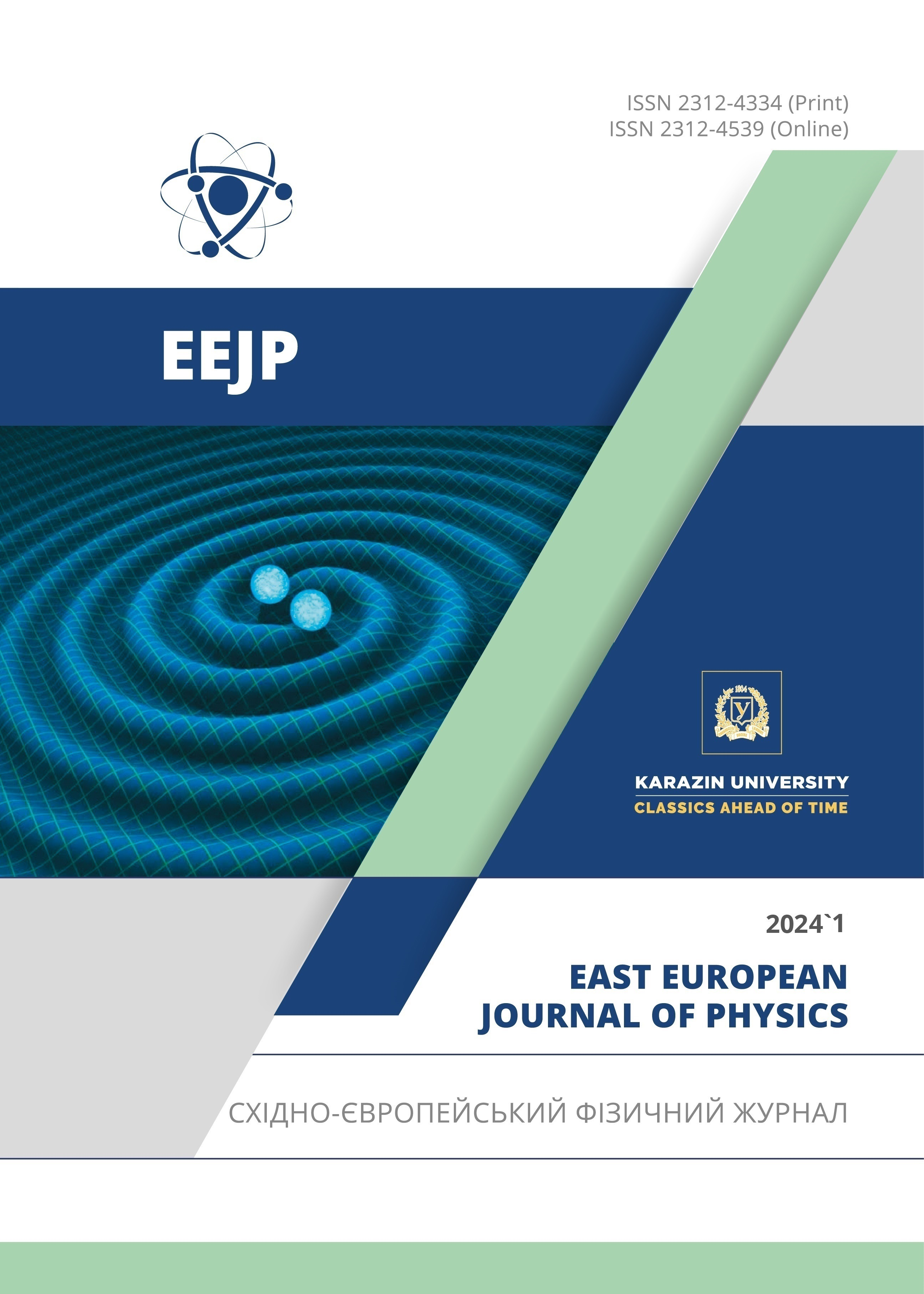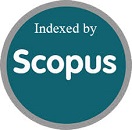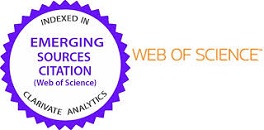Вплив топологічних дефектів і магнітного потоку на енергію дисоціації кварконію в анізотропній плазмі
Анотація
У цій статті ми досліджуємо вплив анізотропних параметрів, топологічних дефектів і магнітного потоку на енергію дисоціації боттомонію в анізотропній кварк-глюонній плазмі. Ми використовуємо тривимірне рівняння Шредінгера та отримуємо власні значення енергії. Наші результати показують, що енергія дисоціації зменшується зі збільшенням температури, але є невеликий зсув у бік вищих значень, коли збільшується магнітний потік. Крім того, включення топологічних дефектів викликає подальші зрушення в енергії дисоціації при високих температурах. Крім того, ми аналізуємо вплив анізотропного середовища на енергію дисоціації, як з урахуванням, так і без урахування топологічних дефектів. Ми спостерігаємо, що включення топологічних дефектів призводить до більш високих значень енергії дисоціації при всіх температурах, тоді як їх ігнорування призводить до нижчих значень при всіх досліджуваних температурах. Крім того, ми розглядаємо баріонний хімічний потенціал і знаходимо, що його вплив на дисоціацію є незначним у порівнянні зі змінами температури. Ці висновки дають цінну інформацію про поведінку важких кварконієвих систем за різних фізичних умов і сприяють нашому розумінню топологічних ефектів в анізотропних середовищах.
Завантаження
Посилання
M. Abu-Shady, and A.N. Ikot, “Analytic solution of multi-dimensional Schrodinger equation in hot and dense QCD media using the SUSYQM method,” The European Physical Journal Plus, 134(7), 321 (2019). https://doi.org/10.1140/epjp/i2019-12685-y
M. Abu-Shady, and H.M. Fath-Allah, “Melting of quarkonium in an anisotropic hot QCD medium in the presence of a generalized Debye screening mass and Nikiforov-Uvarov's method,” International Journal of Modern Physics A, 35(21), 2050110 (2020). https://doi.org/10.1142/S0217751X20501109
M. Abu-Shady, T.A. Abdel-Karim, and E.M. Khokha, “Binding energies and dissociation temperatures of heavy quarkonia at finite temperature and chemical potential in the N-dimensional space,” Advances in High Energy Physics, 2018, 1-12 (2018). http://dx.doi.org/10.1155/2018/7356843
M. Abu-Shady, “Quarkonium masses in a hot QCD medium using conformable fractional of the Nikiforov-Uvarov method,” International Journal of Modern Physics A, 34(31), 1950201 (2019). https://doi.org/10.1142/S0217751X19502014
M. Abu-Shady, “The effect of finite temperature on the nucleon properties in the extended linear sigma model,” International Journal of Modern Physics E, 21(06), 1250061 (2012). https://doi.org/10.1142/S0218301312500619
M. Abu-Shady, “Meson properties at finite temperature in the linear sigma model,” International Journal of Theoretical Physics 49, 2425-2436 (2010). https://doi.org/10.1007/s10773-010-0428-9
M. Abu-Shady, “Nucleon Properties Below the Critical Point Temperature,” International Journal of Theoretical Physics, 50, 1372-1381 (2011). https://doi.org/10.1007/s10773-010-0646-1
M. Abu-Shady, and M. Soleiman, “The extended quark sigma model at finite temperature and baryonic chemical potential,” Physics of Particles and Nuclei Letters, 10, 683-692 (2013). https://doi.org/10.1134/S1547477114010026
M. Abu-Shady, “Chiral logarithmic sigma model at finite temperature and baryonic chemical potential,” Modern Physics Letters A, 29(34), 1450176 (2014). https://doi.org/10.1142/S0217732314501764
M. Abu-Shady, and H.M. Mansour, “Nucleon properties in the quantized linear sigma model at finite temperature and chemical potential,” Journal of Physics G: Nuclear and Particle Physics, 43(2), 025001 (2015). https://doi.org/10.1088/0954-3899/43/2/025001
M. Abu-Shady, H.M. Mansour, and A.I. Ahmadov, “Dissociation of quarkonium in hot and dense media in an anisotropic plasma in the nonrelativistic quark model,” Advances in High Energy Physics, 2019, 4785615 (2019). https://doi.org/10.1155/2019/4785615
M. Abu-Shady, A. N. Ikot, Dissociation of nucleon and heavy baryon in an anisotropic hot and dense QCD medium using Nikiforov–Uvarov method. Eur. Phys. J. Plus 135, 406 (2020). https://doi.org/10.1140/epjp/s13360-020-00436-2
M. Abu-Shady, “Studying quarkonium in the anisotropic hot-dense quark-gluon plasma medium in the framework of generalized fractional derivative,” Revista Mexicana de Fisica, 69(4), 040801-1 (2023). https://doi.org/10.31349/RevMexFis.69.040801
A.L.C. de Oliverira, and E.R.B. de Mello, Int. J. Mod. Phys. A, 18, 3175 (2003).
E.R.B. de Mello, and C. Furtado, Phys. Rev. D, 56, 1345 (1997).
F. Ahmed, “Topological Effects with Inverse Quadratic Yukawa Plus Inverse Square Potential on Eigenvalue Solutions,” Grav. Cosmol. 29, 232–239 (2023). https://doi.org/10.1134/S0202289323030039
A. Vilenkin, “Cosmic strings and domain walls,” Physics Reports, 121(5-6), 263-315 (2000). https://doi.org/10.1016/s0370-1573(99)00103-4
P.A.R. Ade, et al., (Planck Collaboration), “Planck 2015 results - XXIV. Cosmology from Sunyaev-Zeldovich cluster counts,” Astronomy & Astrophysics, 594, A24 (2016). https://doi.org/10.1051/0004-6361/201525833
T. Matsuda, K. Tomita, and H. Sato, “Large-scale structure formation by global defects of the A2 type,” Astrophysical Journal, 686(1), 1-20 (2008). https://doi.org/10.1086/590073
L. Thakur, N. Haque, U. Kakade, and B.K. Patra, “Dissociation of quarkonium in an anisotropic hot QCD medium,” Physical Review D, 88(5), 054022 (2013).
O. Kaczmarek, “Screening at finite temperature and density,” hep-let/07100498 (2007).
M. Moring, S. Ejir, O. Kaczmarek, F. Karsch, and E. Laermann, PoSLAT, 2005, 193 (2006).
B. Liu, P.N. Shen, and H.C. Chiang, “Heavy quarkonium spectra and dissociation in hot and dense matter,” Physical Review C, 55(6), 3021 (1997).
A.F. Nikiforov, and V.B. Uvarov, Special Functions of Mathematical Physics, (Birkhauser, Basel, 1988).
M. Abu-Shady, and E.M. Khokha, “Bound state solutions of the Dirac equation for the generalized Cornell potential model,” International Journal of Modern Physics A, 36(29), 2150195 (2021). https://doi.org/10.1142/S0217751X21501955
M. Abu-Shady, and Sh.Y. Ezz-Alarab, “Conformable fractional of the analytical exact iteration method for heavy quarkonium masses spectra,” Few-Body Systems, 62, 1-8 (2021). https://doi.org/10.1007/s00601-021-01591-7
S. B. Doma, M. Abu-Shady, F. N. El-Gammal & A. A. Amer, Ground states of the hydrogen molecule and its molecular ion in the presence of a magnetic field using the variational Monte Carlo method, Molecular Physics, 114:11, 1787-1793 (2016), DOI: 10.1080/00268976.2016.1154198
Авторське право (c) 2024 М. Абу-Шаді, Етідо П. Іньянг

Цю роботу ліцензовано за Міжнародня ліцензія Creative Commons Attribution 4.0.
Автори, які публікуються у цьому журналі, погоджуються з наступними умовами:
- Автори залишають за собою право на авторство своєї роботи та передають журналу право першої публікації цієї роботи на умовах ліцензії Creative Commons Attribution License, котра дозволяє іншим особам вільно розповсюджувати опубліковану роботу з обов'язковим посиланням на авторів оригінальної роботи та першу публікацію роботи у цьому журналі.
- Автори мають право укладати самостійні додаткові угоди щодо неексклюзивного розповсюдження роботи у тому вигляді, в якому вона була опублікована цим журналом (наприклад, розміщувати роботу в електронному сховищі установи або публікувати у складі монографії), за умови збереження посилання на першу публікацію роботи у цьому журналі.
- Політика журналу дозволяє і заохочує розміщення авторами в мережі Інтернет (наприклад, у сховищах установ або на особистих веб-сайтах) рукопису роботи, як до подання цього рукопису до редакції, так і під час його редакційного опрацювання, оскільки це сприяє виникненню продуктивної наукової дискусії та позитивно позначається на оперативності та динаміці цитування опублікованої роботи (див. The Effect of Open Access).








